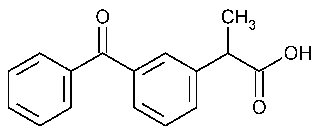Ketoprofen
Benzeneacetic acid,3-benzoyl-a-methyl-,(±)-.
(±)-m-Benzoylhydratropic acid [22071-15-4].
»Ketoprofen contains not less than 98.5percent and not more than 101.0percent of C16H14O3,calculated on the dried basis.
Packaging and storage—
Preserve in tight containers.
Identification—
A:
Infrared Absorption á197Kñ.
Solution:
1in 100,000.
Medium:
a mixture of methanol and water (3:1).
Absorptivities at the wavelength of maximum absorbance at about 258nm do not differ by more than 3.0%,calculated on the dried basis.
Specific rotation á781Sñ:
between +1 and -1
and -1 .
.
Test solution:
10mg per mL,in dehydrated alcohol.
Loss on drying á731ñ—
Dry it in vacuum at 60 for 4hours:it loses not more than 0.5%of its weight.
for 4hours:it loses not more than 0.5%of its weight.
Residue on ignition á281ñ:
not more than 0.2%.
Heavy metals,Method IIá231ñ:
0.002%.
Chromatographic purity—
pH3.5Buffer—
Dissolve 68.0g of monobasic potassium phosphate in 1000mLof water,and adjust with phosphoric acid to a pHof 3.5±0.05.
Mobile phase—
Prepare a suitable filtered and degassed mixture of water,acetonitrile,and pH3.5buffer(55:43:2).Make adjustments if necessary (see System Suitabilityunder Chromatography á621ñ).
System suitability solution—
Prepare a solution in Mobile phasecontaining about 0.01mg per mLof USP Ketoprofen RSand 0.005mg per mLof 3-benzoylbenzoic acid.[NOTE—Protect this solution from light.]
Standard solution—
Dissolve an accurately weighed quantity of USP Ketoprofen RSquantitatively in Mobile phaseto obtain a solution having a known concentration of about 0.002mg per mL.[NOTE—Protect this solution from light.]
Test solution—
Transfer about 100mg of Ketoprofen,accurately weighed,to a 100-mLvolumetric flask,dissolve in and dilute with Mobile phaseto volume,and mix.[NOTE—Protect this solution from light.]
Chromatographic system
(see Chromatography á621ñ)—The liquid chromatograph is equipped with a 233-nm detector and a 4.6-mm ×15-cm column that contains 3-µm packing L1.The flow rate is about 1.0mLper minute.Chromatograph the System suitability solution,and record the peak responses as directed for Procedure:the relative retention times are about 0.8for 3-benzoylbenzoic acid and 1.0for ketoprofen;the resolution,R,between 3-benzoylbenzoic acid and ketoprofen is not less than 4;the column efficiency,determined from the ketoprofen peak,is not less than 2250theoretical plates;and the tailing factor for the ketoprofen peak is not more than 2.0.Chromatograph the Standard solution,and record the peak responses as directed for Procedure:the relative standard deviation for replicate injections is not more than 5%.
Procedure—
Separately inject equal volumes (about 20µL)of the Standard solutionand the Test solutioninto the chromatograph,run the chromatograph for seven times the retention time for ketoprofen,record the chromatograms,and measure the areas for the peaks.Calculate the percentage of each impurity by the same formula:
10,000(C/W)(ri/rS),
in which Cis the concentration,in mg per mL,of USP Ketoprofen RSin the Standard solution;Wis the weight,in mg,of Ketoprofen taken to prepare the Test solution;riis the response of each individual peak,other than the main ketoprofen peak,obtained from the Test solution;and rSis the response of the main ketoprofen peak obtained from the Standard solution:not more than 0.2%of any individual impurity is found,and the sum of all impurities found is not more than 1.0%.
Organic volatile impurities,Method IVá467ñ:
meets the requirements.
Assay—
Dissolve about 200mg of Ketoprofen,accurately weighed,in 25mLof alcohol.Add 25mLof water and several drops of phenol red TS,and titrate with 0.1Nsodium hydroxide having been standardized by a similar titration of primary standard benzoic acid.Perform a blank determination,and make any necessary correction.Each mLof 0.1Nsodium hydroxide is equivalent to 25.43mg of C16H14O3.
Auxiliary Information—
Staff Liaison:Clydewyn M.Anthony,Ph.D.,Scientist
Expert Committee:(PA2)Pharmaceutical Analysis 2
USP28–NF23Page 1099
Phone Number:1-301-816-8139
